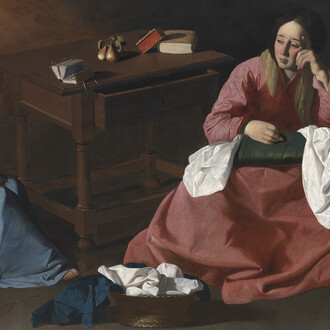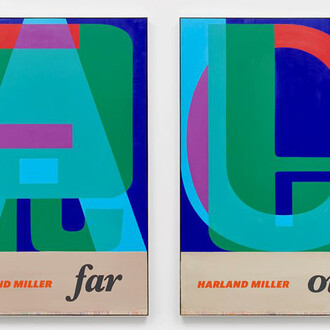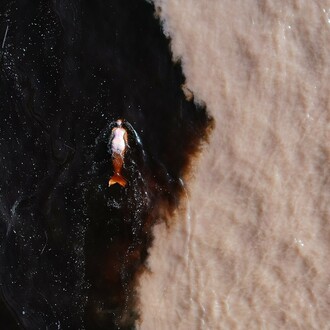This exhibition is an excavation of overarching themes, the complexity of artistic practice and the interweaving and colliding of the past and present. It introduces different viewpoints of scale, culture, life, and art experiences.
(Deborah Smith, curator)
Excavation: macro to the micro is a journey of exploration and discovery, from the broad and expansive to the detailed and intricate. The exhibition presents 22 artists, in five sections, with the starting point being large scale paintings – the macro – by Jenny Saville, Tim Stoner, Nigel Cooke, Alvaro Barrington and Pam Evelyn.
Nuanced layers of information or concepts within each of the paintings inspired the work – the micro – of the following artists on view: Helena Pritchard, Oliver Beer, Renee So, Louise Giovanelli, Nicola Ellis, Leo Fitzmaurice, Anne Tallentire, Nnena Kalu, George Shaw, Isabelle Young, Alice Channer, James Collins, Tanoa Sasraku, Emii Alrai, Dawn Ng, Matt Bryans and Nina Chua.
Jenny Saville’s Fate 1, 2018 (from the series Ancestors) is a collage of classical figuration and modern abstraction in the depiction of a monumental human form; an acute awareness of how the body has been represented over time and across cultures.
That excavation of body/parts, art forms, histories/culture is then explored in Renee So’s ceramic works, Woman holding cup XVI, 2022, Mom jeans II, 2024 and Woman stoneware series and The information age (technicolour), 2022 stained-glass in collaboration with Piotr Franc. The work crosses cultures and time, drawing upon early fertility idols and celebrating the female form.
Performers' bodies become vessels in Oliver Beer’s video Composition for mouths (‘songs my mother taught me) I and II, 2018. By joining their lips in a tight seal to create a single mouth cavity, childhood songs are transformed into an acoustic frequency, where the meeting point of the two voices resonates as a third voice.
Mascara drawings, 2023 by Helena Pritchard investigates modern materials, exploring the aesthetics of daily life.
Louise Giovanelli explores the tension between representation and materiality, figuration and abstraction and how the process of painting carries and conveys meaning. Orbiter 2021 is part of a series of detailed images originating from stills of a performer in a shimmering gold sequined dress – the torso breaking down and dissolving into particles of reflected light. The surface is delicate and luminous, with a light-emitting splendour interweaving glamour and the spectacle of pop performances and the presence of gold in religious painting, used to denote the divine.
Álvaro Barrington’s Compass posse (Deanna), 2021 is part of a series of square canvases made with textiles, on which he draws silhouettes against an abstract background. The series reflects the cross-pollination of many influences, including culture, fashion, music and art history. His interest in materials extends to making custom-made cement frames, which convey a brutalist aspect and impart a sense of gravity to the paintings, connecting them with the idea of an urban landscape.
The body, the embracing of non-traditional materials and techniques, and references to personal and cultural history are processes that Helena Pritchard embraces using recycled and discarded objects. Random wood, packaging, netting, scrim in Untitled freeform, 2024, Untitled, 2020-2024, Freeform, 2024 are discarded fragments of the everyday, with an emphasis on colour and abstract characteristics.
Leo Fitzmaurice centres on the everyday— drawing our attention to the subtleties of found and discard consumerist items that are so often commonly overlooked. He critiques mass production and the physical structures onto which information is placed, presented, or contained.
From the everyday to the industrial Nicola Ellis’s Powder coated documents 1-6, 2021- 2022 derive from her residency at Ritherdon paint shop. Each panel coated top to bottom with the colours used in the paint shop on a single day. The bespoke panels punctuate the manufacturing line at the end of each colour run.
Tim Stoner’s compositions often take years to coalesce, compressing layers of painting that resist a singular or immediate reading. Hacienda, 2012-2022 reveals an excavation of time, scale, the relationship between space and its activity, constant conversation between the depicted, the interior and the external implications. The visceral laying of colour making up the components of a spectral phenomenon that plays across the canvas.
Yet this, plan, 2023 by Anne Tallentire zooms into the domestic space, in particular her own living environment during the pandemic. Here lines of vinyl tape continue her investigation into materiality and the space that exists around an object. Overlapping the floorplan with cropped paragraph-sized cards taken from specific passages of text, they interrogate and reimagine the space within which we find ourselves confined.
Isabelle Young’s heightened curiosity of her unfamiliarity of Italian architecture is recorded through the lens of her camera. The mystery of classical details, modernity, industrial Italy, are fragments of time, and history, stories for the imagination to unveil.
Nnena Kalu explores space, scale and materiality. The diptych, Drawing 46, 2022, is a complex relationship to space, dictated by the length and reach of her arm and size of the paper. The repetitive drawing process is an extension of the artist’s body creating an intensity of colour and layered flowing lines.
George Shaw’s paintings Thereafter III, 2022 and The foot of our stairs, 2022 trace back to his family home which he left over 30 years ago. The council estate where he grew up has been a constant source of inspiration in hir work, exploring the impact of place through urban architecture, housing estates and nature, all which carry a sense of raw imperfect nostalgia central to Shaw’s memory. The title Coming up for air, 2017 is a book by George Orwell where Shaw takes on the protagonist to capture the spaces - ‘scraps of history’ - that remain and the shapes we leave behind.
Pam Evelyn’s gestural paintings are expansive, abstract canvases, densely layered, richly textured meditations on nature and materiality. Cool cast, 2020 presents a complexity of texture, a vivacious composition with a sensitivity towards landscape structures. The canvas is continuously played with, and drips and blemishes are left like scars. The application of oil paint allows for a malleability and fluidity of countless gestural iterations across the panels, imbuing the painting with a sense of urgency and preciousness - containing a raw trace of human nature in sometimes its most vulnerable state.
James Collins’ series Lithic roots, 2024 are made deliberately and slowly, often over several years. He employs additive means to excavate shapes and forms that emerge from within and beneath, as if always there. In his meticulous, densely layered paintings, gradual accretions of oil are built into mounds, furrows, and channels, becoming topographical sites of intense colour.
Tanoa Sasraku’s Sleeve front L, 2023 (from the Terratypes series) of heavily worked sheets of blank newsprint are hand-rubbed with foraged natural pigments from as far as Cornwall, Scotland to Ghana, where they take on geological and geographical information in ochre, graphite and manganese. The sheets are then stacked, cut and stitched together and cut into her Ghanaian’s father’s garment patterned forms. They are then steeped in seawater. Shards of paper are then gesturally torn away, revealing layers that both expose and encrypt details about the materiality of the land, the body and the artist’s familial legacy.
The selected works from Alice Channer’s Soft sediment deformation, 2018 series are from rendered photographs of the Crackington formation, a section of quilted granite rock which forms part of the Devon coastline in the south-west of England. The geological process behind such a rock formation is called ‘soft sediment formation’, a term Channer inverts in the work’s title. Images of the rock formation are printed on Crepe de chine fabric, which are then laid onto a pleating mould, compressed and steamed at high temperature taking the shape of the mould. Collapsing nature and industrial forms, glitches and ruptures, shows the porousness and fragility of our world.
Emii Alrai’s votives are handcrafted fake artefacts fashioned from clay and then painted to resemble aged bronze. This intricate work spans material investigation in relation to memory, critique of the western museological structures and the complexity of archaeological excavations. The interweaving of landscape, geology, materiality, diaspora, and migration takes us on a complex journey.
Nigel Cooke’s expansive painting Moonlight, 2022 takes its cue from influences of a world map, synonymous with travel and adventure and the Ancient Greek Titan, condemned to carry the heavens on his shoulders for eternity, at once colossal and immaterial. Cooke reimagines the icon with a delicate, diaphanous creature, reflecting his own interrogation of the immense and microscopic systems that govern the natural world. In a classically painterly style, he works to layer his canvases from dark to light, from fine brushstrokes, to create an elegant illusory quality, an emotive abstraction, as if the paintings stretch through space. He talks of where one thing ends and another begins.
Matt Bryans’ Tree line, 2012 is a labour-intensive erasure of time - rubbing away details from small sheets of newsprint, working methodically, collecting, examining and repurposing materials in search of its inherent qualities, creating a new beginning. His work requires investment in time and intention, using a material that bears traces of history, an elaborate ephemeral works.
Dawn Ng has devised an emotive language of creation, destruction, trace and remembrance, an ode to process and fleeting beauty. In Waterfall VIII, 2023, Ng turns ice, an ephemeral material, into a glacial decay while evoking calming waterfalls and collapsing ice shelves. The blocks of frozen pigment are a topographical medley of pigments, watercolours and dyes, a riot of colours. Using a time lapse, she compresses hours of real time into minutes of screen time, capturing moments of being.
Nina Chua makes drawings using marker pen on paper that form an exploration of line, colour and materiality, moving from subtle modulations to bold and clashing marks with a versatility that stems from the directness of drawing. Paper is treated as an object not just a surface to work upon, often drawing on both sides to exploit its permeability, crushing or rolling it into forms and crumpling it to disrupt the flow of the lines. Maker 286, 2020 captures fleeting thoughts and ideas in abstract form, as a marker of a moment in time.
Selected highlights from the exhibition will be presented in The House of KOKO’s Penthouse from 12 –19 September, available to view and experience in VR by members and by appointment.
About the curator: Deborah Smith is a curator and collections consultant who explores different strategies for collaboration and the presentation of interdisciplinary practices. She has delivered exhibitions, large-scale commissions, interwoven with programmes of learning, engagement and interpretation. Smith was previously the Director of the Arts Council Collection, the most widely circulated national collection of modern and contemporary British art, interim Head of Programmes at the Serpentine Galleries, and associate curator at Arup, the global engineering company. She is a judge for the Museum + Heritage Awards, a Shadow Board Member of The Box, Plymouth, a University of Warwick Art Collection Committee member and on the HS2 Independent Design Panel.












